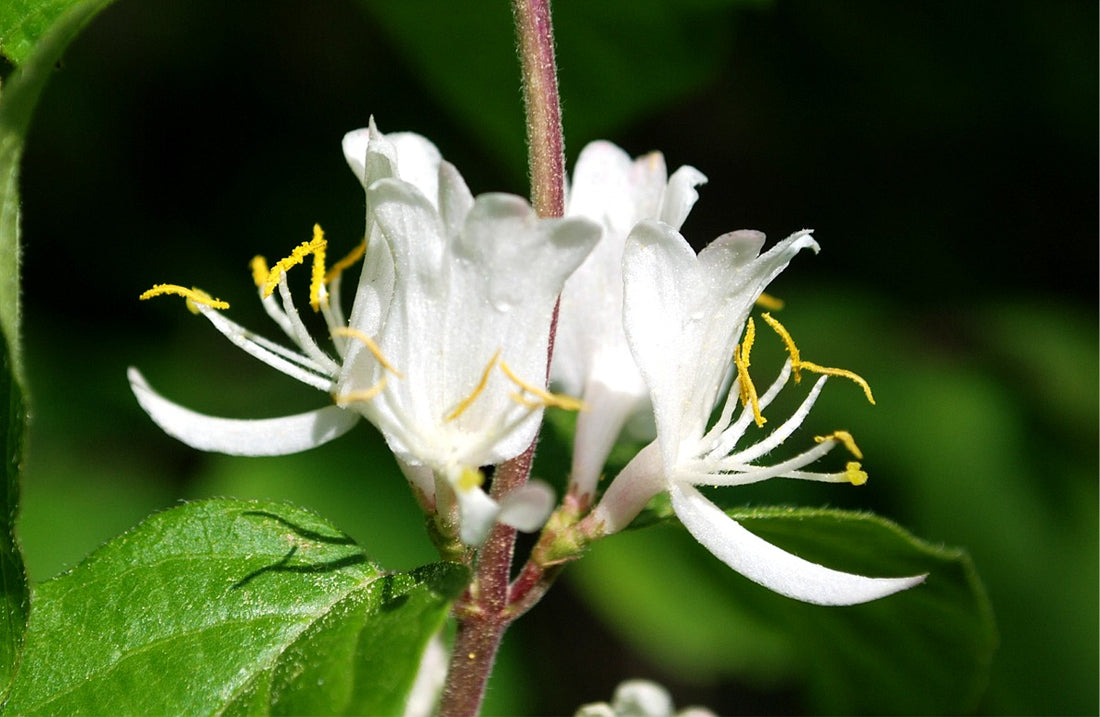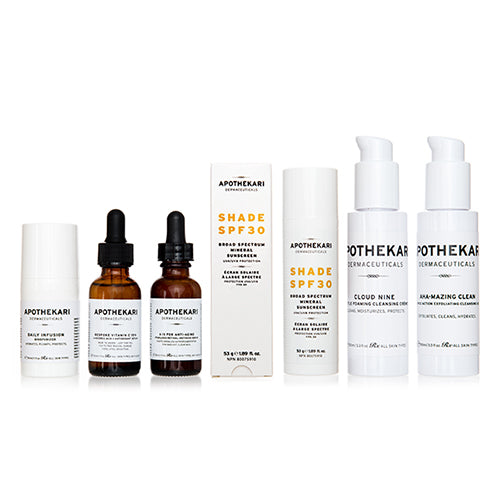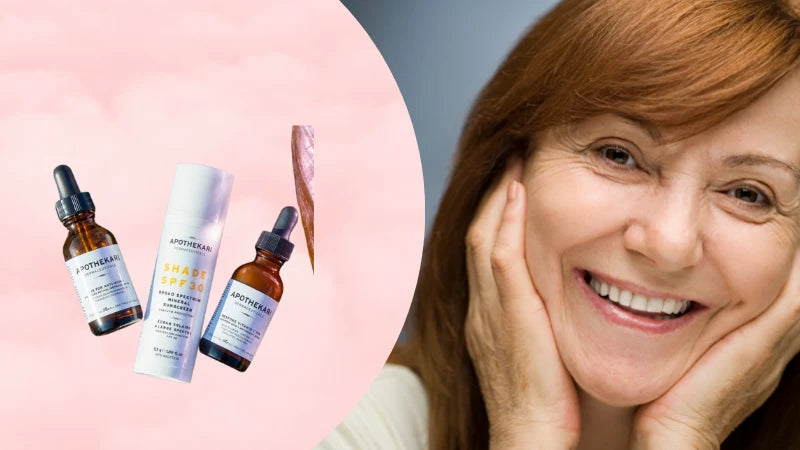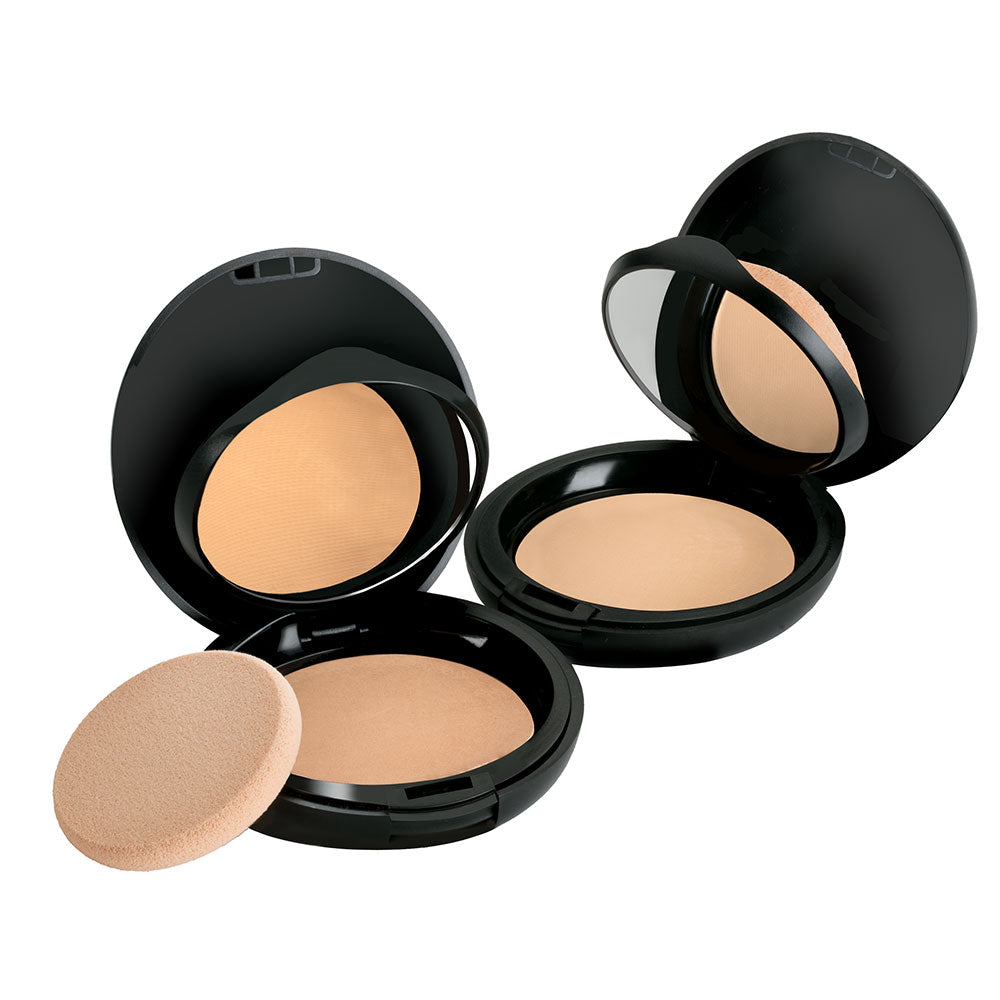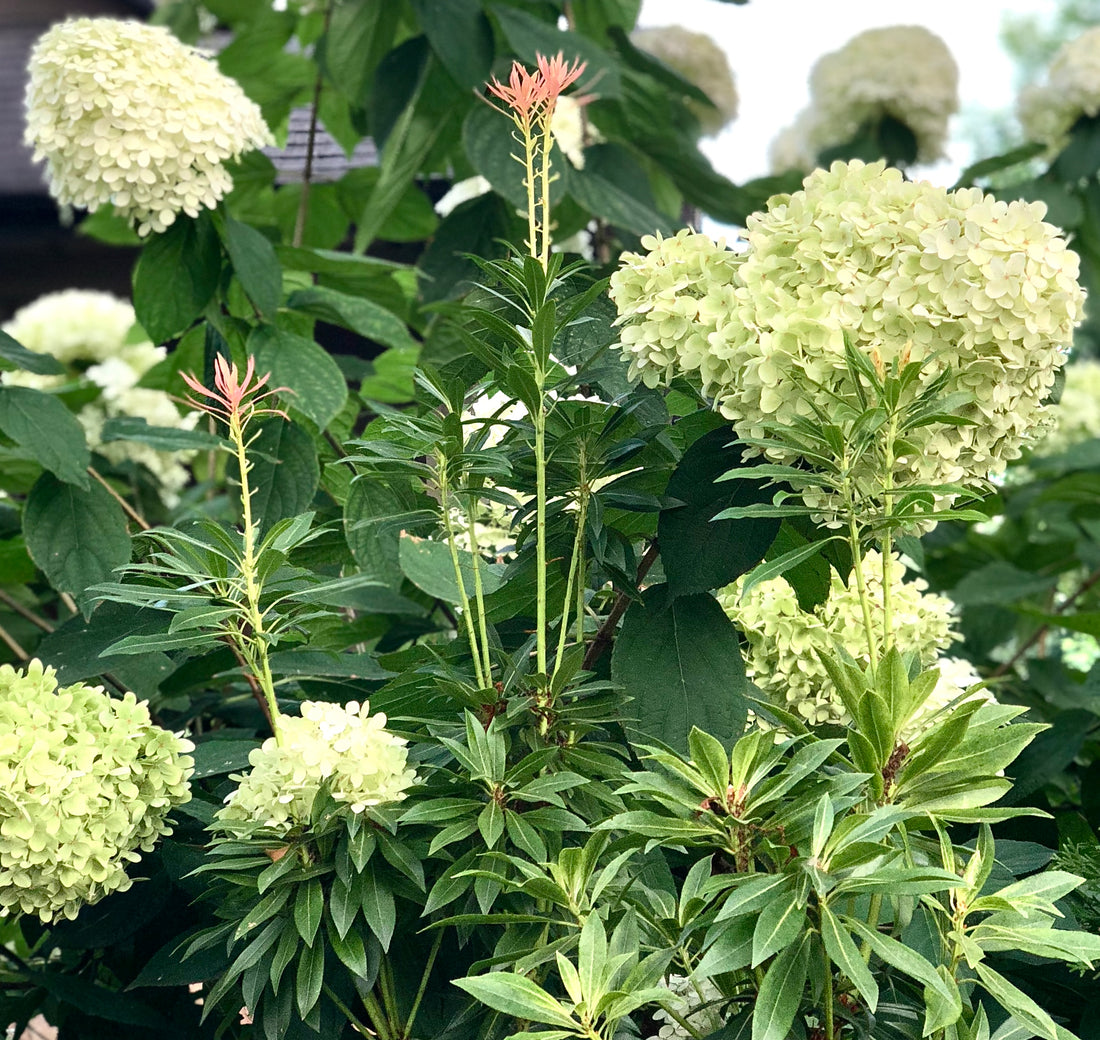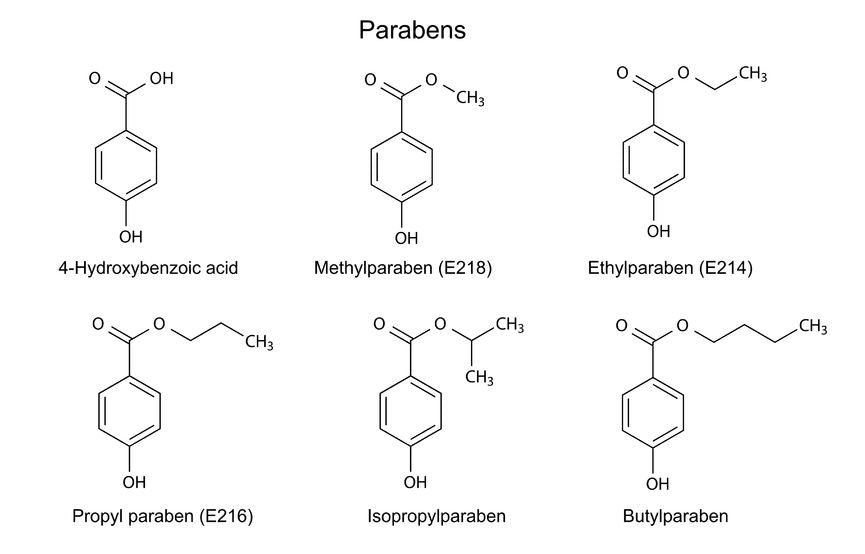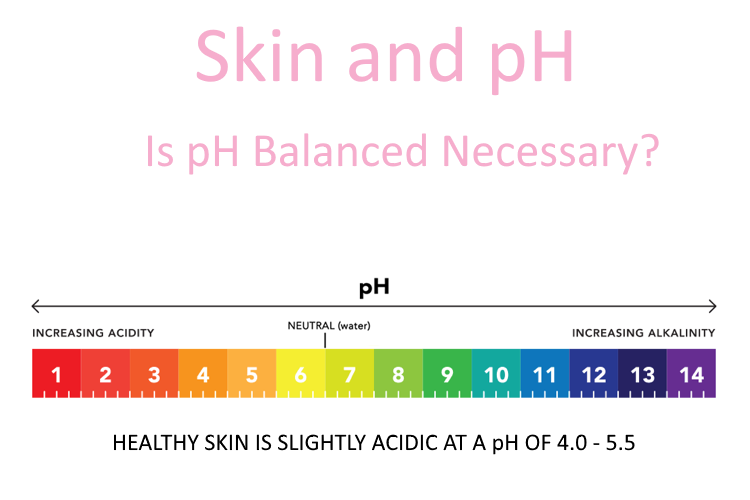Blog
What You'll Want to Know About Ergothioneine (Hint: It's an Antioxidant)
We’re big fans of antioxidants at Apothekari because they do so much for skin and while most of us are familiar with ingredients including Vitamins C and E, alpha lipoic acid, green tea or even ferulic acid, ergothioneine (trade name Thiotaine®) has probably slipped under your radar. Is Ergothioneine an Antioxidant? Ergothioneine (pronounced er-go-thigh-o-neen) is an antioxidant amino acid that occurs naturally in the body. It is found in high concentrations around cells prone to free radical damage, helping to protect their mitochondria (which aid in energy production). Our bodies can’t synthesize it, so we need to obtain it from foods we eat. Mushrooms are one of the richest natural sources of ergothioneine so you’re in luck if you’re a fan. What Is Ergothioneine Good For? While the research to support ergothioneine’s use in skin care is limited, studies have shown that ergothioneine not only prevents oxidative damage but also may enable DNA repair in cells subjected to UV light. In a comparison study against idebenone (Coenzyme Q10), ergothioneine was found to be a faster and more efficient antioxidant in helping to protect against reactive oxygen species (ROS) after exposure to UVA rays. Why Antioxidants Like Ergothioneine? When it comes to antioxidants, the more the merrier, despite what you may have come across. There isn’t one miraculous antioxidant and research has shown that our skin does better when we use a wide range of effective antioxidants rather than just one. Antioxidants play very well with sunscreens so it’s a good idea to use them together. While regular sunscreen use is essential to reducing the risk of developing skin cancer and premature skin aging, antioxidants can help to boost your sunscreen’s effectiveness by fighting against the free radical damage from the UV light that passes through sunscreen (no sunscreen can effectively block 100% of UV rays). Even the best sunscreen can use a bit of additional help from an antioxidant. Is Ergothioneine an Antioxidant? The easiest way to get optimal protection against free radicals is to apply a sunscreen along with antioxidants every morning. We like using our Bespoke Vitamin C Serum, formulated with L-ascorbic acid, and a host of additional antioxidants along with Apothekari Shade SPF 30 every day. Shade SPF 30 contains zinc oxide, an effective broad spectrum UVA/UVB blocking sun filter, plus additional support from red algae extract (a UV absorbing substance) and ergothioneine. The combination of these two products will help to defend your skin against assault from UV rays, pollution and any other stressor it may encounter during the day. Let’s hear it for antioxidants like ergothioneine!
Learn more5 Questions to Ask Before You Choose a Moisturizer
If you’re wondering how to choose a moisturizer that’s right for you, you’re not alone. Moisturizers seem to be the number one requested product when we feel that something is wrong with our skin and in an earlier post I questioned whether or not you even need one. If you do, there are 5 questions to ask before you choose a moisturizer. Shop Daily Infusion Moisturizer What is a Moisturizer? Moisturizer is a broad term used to describe products that we use to make our skin feel more comfortable and lubricated (not dry). They range from very light products like serums and lotions to heavier and more occlusive ones like petroleum jelly. Water itself can moisturize skin but it evaporates very quickly. On the other end of the spectrum, petroleum jelly also moisturizes, but it is sticky and greasy unpleasant to use on a regular basis. An ideal moisturizer for most of us falls somewhere in between the two, containing some water with a heavier, occlusive substance to help lock it all in. Moisturizers are made up of 3 main types ingredients: Humectants. Attract water to the skin by grabbing it from the environment. Can also pull water from deep in the skin (dermis) to the surface layers (epidermis). Examples include honey, propylene glycol, propanediol, hyaluronic acid (sodium hyaluronate), glycerin, ethylene glycol. Emollients. Help to fill in the gaps in skin leaving it feeling softer and smoother. They may also help to lock in moisture. Includes lipids (fats) and oils such as jojoba oil, castor oil, vitamin E and cholesterol and some silicones as well. Emollients may also work as occlusives. Occlusives. Help to lock in water by forming a thin, oily layer over the skin. They work best when applied to damp skin. Examples include petroleum jelly, lanolin, mineral oil, silicones, beeswax, cholesterol and fatty alcohols including cetyl alcohol and stearyl alcohol. Many occlusives are also emollients. We’re big fans of Apothekari Daily Infusion Moisturizer , which contains a good balance of humectants (glycerin), emollients (caprylic/capric triglyceride, coco-caprylate/caprate, squalane) and occlusives (cetearyl alcohol, cetearyl glucoside, glyceryl stearate) and which is suitable for all skin types. How To Choose a Moisturizer Your choice of moisturizer depends on your skin type and the time of year. You may not require a moisturizer during the summer months, when traveling to tropical locations or when the humidity is high. However, when you travel away from home, the weather changes and/or the humidity drops, you may need to reassess your routine. Skin changes due to a number of factors so a routine that always used to work for you may need to be revisited every now and again. Here are 5 questions to ask before you choose a moisturizer that is best for your skin. What is Your Skin Type? Dry skin requires a moisturizer with more emollients and occlusive ingredients to help block water evaporation. Oily skin often does well with water-based products containing a lot of humectants (like a hyaluronic acid serum) or may be able to forgo a moisturizer altogether. Is Your Skin Dry or Dehydrated? Dry skin is skin that is lacking in oils while dehydrated skin is skin that it is lacking in water. Dry skin feels rough and appears dry and flaky. Dehydrated skin looks dull and feels tight and rough. It may show fine lines, sagging and wrinkles. Both oily and dry skin can be dehydrated, meaning that it is lacking in water or moisture. Dehydrated skin benefits from humectants to help hydrate and plump. Ingredients including glycerin, sodium hyaluronate and propanediol work well. What Time of Year is it? If temperatures have dropped and the air is drier (like now) or if you’ve traveled somewhere where that’s the case, you may need to introduce a moisturizer if you aren’t currently using one. Or, you may need to switch to one that contains more emollient and occlusive ingredients. Conversely, if it’s getting warmer and there’s more moisture in the air, you may need to swap out your heavier moisturizer for one that is lighter (more humectants and fewer emollient or occlusives). If you’re spending more time outdoors, consider that the sun’s UVA rays can lead to dehydrated skin so ensure that you are wearing a sunscreen and consider upping the moisturizer. Has Your Skin Experienced Age Related Changes? Our skin may become oilier as we enter adolescence. As we approach our twenties, it becomes drier. The hormonal changes that women experience as they age can lead to further dryness so it’s important to acknowledge that you may require a different moisturizer as you get older. What Type of Moisturizer Do You Like? Sometimes finding the right product can take a bit of trial and error. If you’re not happy with how your moisturizer feels on your skin, it may not be a good match. Shop around and test products until you find one that you enjoy using. Once you’ve found a moisturizer that works for you, keep the following in mind: Apply over damp skin to lock in moisture. Moisturize as often as you need to. Use SPF daily to help combat dryness and skin damage. Did this post help you with how to choose a moisturizer?
Learn moreWelcome PhaMix! Plus a Giveaway...
You already know me as the face behind Apothekari, but what you may not know is that I’m also the founder of PhaMix.com, an online store that stocks a range of Pharmacist curated skin care solutions from head to toe. PhaMix was launched in 2006, almost 12 years ago, a long time when it comes to the internet! If you’ve visited Apothekari.com recently, you may have already noticed a little transformation. Apothekari.com now shares space with PhaMix.com – you can switch between the sites by clicking on the name and site link on the top left hand side of the site. We’re really excited to move on to this exciting next chapter and to celebrate this transition, we’re doing a giveaway containing over $500 worth of products! Welcome PhaMix.com You may wonder why we’ve decided to merge the sites and it’s really about being able to serve you better. We know that you’re fans of Apothekari and while we offer a range of treatments to suit most skin types and needs, as a small brand, we cannot cover solutions for everything. Allowing you to access a wide range of skin care solutions, which I’ve personally curated, with one checkout, will hopefully help to simplify your shopping experience. Beyond science-based skin care solutions for your face, PhaMix offers a range of high SPF suncreens, women’s wellness solutions and effective body treatments. We will be introducing new products and brands to the store so make sure to sign up for the PhaMix newsletter (at the bottom of the site) if you’d like to stay current with our news. You will still be subscribed to our Apothekari newsletter, but FREE SHIPPING remains at $75 if your cart contains $75 of Apothekari products. If you are not purchasing $75 worth of Apothekari products, a total of $125 (which can include Apothekari products) l gets you free shipping within North America. All Apothekari orders will be processed on PhaMix.com moving forward. Enter to Win A Giveaway Worth Over $500! We’re excited about the merge of our two websites and we’re doing a giveaway to celebrate it. The giveaway contains a range of top selling Apothekari products PLUS those at PhaMix and is valued over $500.00! It’s Easy to Enter and Details Are Below The giveaway contains the following products: Apothekari A is for Anti-Aging Serum – Gentle, effective retinoid formulation to reduce appearance of wrinkles and fine lines, increase skin cell turnover, boost collagen and elastin production, brighten skin tone, increase skin moisture content, protect against photo-aging. Apothekari Shade SPF 30 Sunscreen – Non-whitening, zinc oxide mineral sunscreen with added antioxidant protection Apothekari Daily Infusion Moisturizer – Hydrates, plumps and improves skin barrier function to help protect against environmental irritants. Choice of Apothekari Cleanser (our Cloud Nine is pictured but can opt for AHA-Mazing Clean Cleansing Gel). Cloud Nine is a gentle, foaming cleanser that not only cleans, but also moisturizes and protects skin. AHA-Mazing Clean offers a triple alpha hydroxy acid combination to gently exfoliate clogged pores and promote cellular renewal. Apothekari Shea Body Butter – Organic shea butter is infused with healing herb and fresh oils and an intoxicating blend of essential oils to heal dry, cracked and callused skin. Apothekari Bamboo Lemongrass Foaming Body Polish – Consider this your secret spa! Revitalize and invigorate your skin and your senses with walnut shell powder, powdered bamboo and a light, refreshing essential oil blend of lemongrass, mimosa, and litsea! Apothekari Vanilla Rose Sugar Body Polish – Smooth, non-drippy sugar polish with a modern and subtle scent of rose plus a faint hint of vanilla. Ideal for aromatherapeutic body treatments or a little pampering in your bath. Apothekari Lemon Verbena Sugar Body Polish – Smooth, non-drippy sugar polish with a bright, aromatic citrus scent Ideal for arom.atherapeutic body treatments or a little pampering in your bath. Anthelios XL SPF 60 Melt-In/Comfort Cream – Broad spectrum UVA/UVB sun protection formulated with Mexoryl technology. Dermatololgist recommended. Yes Organics Intro Pack (Natural Lubricants) – Yes Intro Pack is an easy way for you to try three different Yes Natural Lubricants – Yes Water Based Natural Lubricant, Yes Oil Based Natural Lubricant and a new Yes Oil Based Applicator Lubricant. Certified organic. Avene Sunscreen High Protection Spray SPF 50+ – Broad spectrum UVA/UVB sun protection formulated with Tinosorb S and Tinosorb M. Convenient spray application. Ombrelle Face Stick SPF 50+ – Broad spectrum UVA/UVB sun protection featuring Mexoryl technology. Convenient and portable stick application ideal for face, ears, lips. Neostrata Wrinkle Repair – This winning combination of retinol plus peptides is clinically proven to reduce the appearance of deep wrinkles. La Roche Posay Cicaplast Levres (Lips) – Soothing, protective lip treatment to help with chapped, cracked and irritated lip. Ureaka Hand Cream – This formula has been found to actively restore moisture even to very dry, cracked and/or flaky skin. Formulated with urea, an essential component of the body’s Natural Moisturizing Factor (NMF). Giveaway Contest Rules Here are the contest rules: The contest is open to anyone residing in Canada and the USA. You will receive ONE entry for each follow across our PhaMix social media platforms – links below and on PhaMix.com at the bottom of the site. This includes shares and retweets. Please note that tagging is limited to three. Instagram (phamix_skin) Facebook (PhaMixSkin) Pinterest (phamix_skin) Twitter(PhaMix_Shop) The contest starts now and ends on Saturday, November 10th, 2018. The draw date will be announced on our social media posts and the winner will be notified after the draw is held. GOOD LUCK ALL!
Learn more5 Novel Skin Care Ingredients You May Not Know About
I’m an advocate of sticking with ingredients that are tried and true when it comes to skin, but sometimes novel skin care ingredients arrive. They often show promise, but may not have the research or experience to back up their claims. Before jumping on the bandwagon about an ingredient that may or may not deliver on its promises, it’s often a good idea to await more clinical studies to help you determine whether they may be a good fit for your skin. Shop All Apothekari In this post, let’s take a closer look at 5 novel skin care ingredients that you may not know about which have the potential to be skin care superstars. 1. Bakuchiol Derived from the seeds of the Psoralea corylifolia plant, aka the “babchi” plant, bakuchiol has origins in Ayurvedic medicine, where it has been shown to have antioxidant and anti-inflammatory properties, as well as antibacterial properties. In skin care, bakuchiol has properties similar to retinol, helping to stimulate collagen production thereby increasing cell turnover and diminishing signs of aging such as fine lines, wrinkles, skin laxity, and photodamage. Studies have shown that it is far less irritating to skin compared to retinol. And, it can be used in combination with retinoids. 2. SMART Drone Peptide Technology This high-tech newcomer was developed using principles of drone navigation technology to target specific areas of the skin to boost the synthesis of hyaluronic acid and elastin. It is purported to help skin to look smoother, hydrated and less crumpled and improves visible bounce back. This technology works by wrapping one peptide inside a capsule and another to surround the outside of the capsule. The peptide on the outside helps to guide the capsule to the correct site in within the skin, where the first peptide is released to work its magic. The outside peptide also has the added benefit of stimulating elastin synthesis. How sci-fi does this sound?! 3. Rosa Damascena Flower The growing conditions for the Rosa damascena flower in Turkey produce specific and delicate fragrance properties. Here, flowers are gathered by hand in rose gardens each morning before sunrise removes the first dew found on the petals. It is used not only for its heavenly fragrance (which has a calming and soothing effect on mood) but also for its hydrating, anti-inflammatory and antioxidant-rich properties. Find rosa damascena in our Bamboo Lemongrass Foaming Body Polish, Shea Body Butter and Vanilla Rose Sugar Body Polish. 4. Starflower Seed Oil Also known as borage oil, the seeds from the starflower plant are a rich source of gamma-linolenic acid (GLA), a fatty acid that is extremely helpful in treating dry skin conditions. Borage oil helps to maintain skin moisture levels and is an incredible nourishing and hydrating ingredient, which helps to skin look and feel healthy. 5. Persian Silk Tree Albizia julibrissin, also known as the Persian Silk Tree, is a tree native to East Asia and South America. Studies have shown that it has antioxidant, anti-tumor and anti-inflammatory properties and it is used in skin care to protect against glycation, a process that results in loss of skin elasticity and which ages the appearance of skin. Have you tried any of these novel skin care ingredients? Share your experience below.
Learn moreAre You Ready for the Skin Care Diet?
If even the thought of the word ‘diet’ makes you cringe, you’ll be happy to know that the skin care diet doesn’t focus on what you put in your mouth. Don’t worry about cutting back on gluten, sugar or alcohol, the skin care diet making the waves right now, focuses on what you put on your skin. Thought to be a push-back against one of the latest trends to hit the beauty world, “The 10 Step Korean Skin Care Routine”, the skin care diet emphasizes how to minimize the steps in your skin care routine. As someone who’s a minimalist when it comes to skin care, I can’t even begin to imagine the number of products and the amount of time it would take to implement a 10 step skin care routine on a regular basis. While the end goal of the skin care diet is to decrease irritation, I see how this would not only free up significant amounts of time PLUS leave more money to spend on other things. It’s not surprising that skin bombarded with lots of actives on a daily basis may struggle. This can become extremely problematic if one loads up on products containing retinoids, alpha hydroxy acids and/or low pH ingredients (like Vitamin C) all in one go. Products that are either incompatible or harsh can result in the development of redness, sensitivity and irritation. More serious cases may result in contact dermatitis, a condition that presents with large, burning, and itchy rashes that can take anywhere from several days to weeks to heal. Why a Skin Care Diet? The word diet is involved because it’s a way of eliminating products that may be harming your skin or which may be unnecessary. Individuals are advised to cut back to the basics – a cleanser, moisturizer and a sunscreen, products which typically tend to be free of potentially harsh active ingredients. This regimen may be compared to an elimination diet that is often recommended to help individuals with suspected food allergies. You remove most things from your skin care regimen and then gradually reintroduce those that you consider essential, one at a time. This process allows you to determine how your skin tolerates and responds to each treatment and helps you make certain that you aren’t introducing ones that are problematic for your skin. When it comes to your skin, more steps and products are not necessarily better and it’s never a bad idea to simplify your skin care regimen. At Apothekari, we recommend 4 steps to great skin – Cleanse, Prevent, Protect and Treat (for individual skin concerns). It’s possible to get away with just 3 products and then add one or two for specific issues. I don’t know about you, but I’ll take 3 or 4 steps over 10 any day!
Learn moreSilicone Safety in Cosmetics – Should You Be Concerned?
You may have read negative reviews about silicone safety when it comes to your cosmetics. Synthetic ingredients that are a combination of silicon (a hard, brittle solid), oxygen and other elements including carbon and hydrogen, silicones are widely used in the skin care world for the many benefits they bring to formulations. In this blog post, we take a closer look at this ingredient to help you determine if silicone safety is something that should be on your radar. Shop All Apothekari Why Use Silicones in Skin Care? You can recognize silicones in an ingredient list by their name ending – most end in -cone or -siloxane; for example, dimethicone, cyclomethicone, cyclopentasiloxane. Silicones have unique fluid properties and help make formulations much softer and easier to spread. They are often added to improve the feel, appearance and performance of topical skin and hair care products and they can also help to improve the delivery of other ingredients. Silicones are ideal in make-up primers, BB creams and foundations giving fluidity, silkiness and smoothness. They can help to condition, give emollience and help to prevent water loss. Skin can appear smoother and more radiant because they also reflect light and can help to fill in lines and pores. They are also used in shampoos and conditioners to give hair a smooth, shiny and finished look. When it comes to silicone safety, they are generally considered safe with topical application. However, you’ll still come across claims that they are problematic or dangerous despite the lack of scientific research to substantiate this. Silicone is considered hypoallergenic and non-comedogenic and not known to sensitize the skin. Because it can increase the penetration of other ingredients, it is possible to experience issues if those other ingredients are not compatible with your skin type. For example, silicone may increase the penetration of potentially pore-clogging ingredients, thereby leading to the development of acne. It is also possible to have a silicone allergy, especially if you have sensitive skin, including acne-prone or rosacea. Silicone Safety – A Concern? The drawbacks of silicones tend to be associated with their semi-occlusive effect. While this effect helps to deliver smoother skin and scalp plus protection from harmful external influences (i.e. pollution) it may lead to the following negative consequences: Occlude pores and make breakouts worse. Build up on the skin leading to a dull appearance. One more reason to ensure a good cleansing every night! When it comes to hair, the accumulation may lead to reduced volume, hair that retains fats, a quicker secretion of oils – leading to an increased need for washing. Pilling. Topical application that can result in little balls when rubbing the skin is known as pilling. While silicone may be safe for the skin, their use does come with some environmental impact, which is potentially more troubling. Silicone molecules are highly stable and not very biodegradable, taking between 400-500 years to decompose. Many government bodies have found detectable levels in aquatic life, leading to the potential for disruption of the ecosystem and human consumption. We’re not sure about the long term consequences when it comes to this area so more guidance and research are welcome. In general terms, when it comes to silicone safety, they are harmless. However, if you’re concerned about their occlusive effect, build up on your skin and/or hair or their environmental impact, you may wish to avoid using them in your personal care products. If you feel that the positives of using silicones is greater than any potential negatives, the following will help you to better incorporate them into your routine: Cleanse thoroughly at night to remove any silicone build-up from the day. Avoid silicone formulations at bedtime. This will help to protect your skin during the day but allow it to breathe at night. If pilling is problematic, avoid silicone creams and foundations. Hair care products with silicones (often dimethicone) can accumulate, making your hair heavier and low in volume. Consider alternating with a silicone-free formulation or eliminating them altogether. In my case, I’ve chosen to avoid the use of silicones in my personal care routine. My hair looks and feels shinier and smoother (which seems counter intuitive, but it’s true), I don’t have to worry about build up on my skin, leaving it looking more radiant and glowing. Whether or not to avoid silicones in your regimen, is really a matter of personal preference and I hope that this post has given you the information to make an informed decision. If you’re still concerned about silicone safety, you’ll be happy to know that Apothekari is formulated without the use of silicones. Additionally, our line is also Paraben-free, Phthalate-free, Formaldehyde-free, SLS/SLES-free, Synthetic colourant and fragrance-free, Cruelty-free. Read more about our skin care philosophy here.
Learn more3 Reasons To Fall in Love With Bamboo Powder
You may have noticed an increase in the use of bamboo powder in skin care products recently. Hailing from Asia, bamboo is an exotic grass, which happens to be one of the fastest growing plants on earth, making a readily renewable and sustainable plant resource. Once it’s cut, the root system sends out new shoots for re-growth without any need for it to be replanted. It grows all over the world in natural environments without the need for any fertilizers or pesticides. It gives off 35% more oxygen then trees and has a huge variety of uses, including clothing fibres, building material, food and medicine. Shop Apothekari Bamboo Lemongrass Foaming Body Polish What Is Bamboo Extract Powder Good For? While a late comer to the cosmetics game, bamboo powder is making its way into a range of products, including our Bamboo Lemongrass Foaming Body Polish. While many of us think of bamboo as a decorative planting for the garden, this attractive grass comes with several attributes that make it a useful addition to skin care formulations as well. Bamboo powder is known to contain various compounds, including flavones, glycosides, phenolic acids, and amino acids, which together provide a range of skin benefits. Here are 3 reasons why you may just fall in love with bamboo powder: It Exfoliates. It differs from most other physical exfoliants because it is fine enough to deliver very gentle, yet effective exfoliation. It Has Antioxidant Properties. Containing various compounds, the flavones in bamboo extract give it antioxidant properties, which help to defend against free radicals. It Has Anti-Inflammatory Properties. Which helps to soothe red and irritated skin. The Chinese have known for centuries that if you cut your skin and put bamboo on it, it’ll heal faster. A study has confirmed this as well, thanks to several constituents of bamboo powder that deliver this benefit. Are you ready to give bamboo powder a go?
Learn more3 Holy Grail Skin Care Products
In this blog post, I’m going to share with you the most important products in my skin care routine, or what I like to refer to as my Holy Grail Skin Care products. Like you, I’m a pretty busy kind of woman so when it comes to managing my life, I’m always on the lookout for ways to simplify things. If there’s a faster, easier or better way to do something, I want to know about it. Radiant Skin Set SHOP RADIANT SKIN SET These Are the 3 Holy Grail Skin Care Products There are lots of good skincare products to choose from, but 3 make the biggest impact on your skin. My hope in sharing these 3 products is that it will help you to prioritize the items in your skin care regimen. If you are inspired to purchase and use fewer products, you’ll benefit from saving time both morning and at night, dealing with less clutter and making a smaller dent in your wallet. You don’t need dozens of skin care products; you just need a few of the right ones. The ones I discuss below are the ones that I consider as my holy grail skin care products. These are products that contain ingredients, which are backed by science to deliver results. The best part is that in my case, there are only 3! Let’s get to it then, shall we? Holy Grail Skin Care #1 Sunscreen You may be sick of hearing me stress the importance of daily sunscreen use. However, protecting your skin from sun exposure is hands down, the MOST important thing you can do to help keep your skin looking young and healthy. Exposure to ultraviolet rays is contributes to more than 80% of skin aging. If I say it all the time, it’s because it really is that important! While most of us are quite familiar with the effects of UVB rays – sunburn, anyone – we appreciate the importance of wearing sunscreen during the warmer, summer months or while visiting faraway tropical locations. UVA rays however, the ones that penetrate deep into the dermis, may not seem to carry as many negative effects but they are responsible for premature skin aging, contributing to both wrinkles and skin aging. They are prevalent year round and can pass through glass, clouds and windows. Both types of rays contribute to skin cancers so it’s not just our vanity at stake here, we’re also talking about our health. Whether you opt for a chemical or physical blocking sunscreen, ensure that it: Protects against both UVA and UVB rays Is photostable (won’t degrade upon exposure to sunlight) and Is a formulation that you enjoy using it. I’m partial to Shade SPF 30, our new mineral based zinc oxide sunscreen, which provides broad spectrum UV protection in a non-whitening base. It’s one of my go-tos every morning. Holy Grail Skin Care #2 A Retinoid It’s not just me, but ask any skin care professional about the importance of retinoids and you will get resounding agreement. Retinoids are absolutely essential to anyone serious about their skin. Derived from vitamin A, retinoids are a class of ingredients that deliver multiple skin benefits – unclogging pores, boosting collagen production to reduce wrinkles and fine lines, speeding up skin cell turnover to even out skin tone & discolouration and smoothing skin as well. Many individuals will start to notice a difference in as little as 4 to 6 weeks. Retinoids have been around since the 1970s when prescription only retinoic acid was approved for the treatment of acne. Soon after, dermatologists and patients began to notice that not only breakouts were diminishing, but that many users experienced a reduction in fine lines and hyperpigmentation as well. Whether you opt for over-the-counter retinol, retinaldehyde or retinyl palmitate or gravitate towards prescription options including retinoic acid or tazarotene, retinoids should be included in your skin care arsenal. Have you tried our A is for Anti-Aging Serum? Formulated with gentle retinaldehyde plus a combination of additional skin actives, it helps to protect against photo-aging, exfoliates, delivers anti-inflammatory/anti-irritant properties and brightens skin as well. Retinaldehyde also demonstrates anti-bacterial properties making it a useful addition in the management of acne as well. Keep the following in mind when using a retinoid: Retinoids are light sensitive so they are best applied at night Retinoids may make your skin worse before it gets better as their use is associated with dryness, redness and flaking. Minimize these side effects by starting slowly, applying one to two nights a week and gradually building up to daily use. If introduced in this way, most individuals can tolerate them well. Don’t use a retinoid if you are pregnant or breastfeeding. Holy Grail Skin Care #3 An Antioxidant Formulation. Which Vitamin C Serum is Best? We’ve written about the importance of using antioxidants previously. Antioxidants are ingredients that help to protect skin from damage caused by free radicals, unstable molecules that cause havoc in the skin, setting off a cascade of skin damage. Free radicals may be generated by pollution, ultraviolet radiation and smoke and we are exposed to them daily. Skin benefits from a mix of antioxidants including Vitamin C (especially L-ascorbic acid, which is backed by the most research), Vitamin E, green tea, ferulic acid, alpha lipoic acid, reservatrol, coenzyme q10, etc. Apply antioxidants in the morning prior to UV exposure in conjunction with your sunscreen to help minimize the impact of free radical damage caused by UV rays. Sunscreens and antioxidants play very well together. Antioxidants may be applied at night as well. While they fight free radicals during the day, at night, they play more of a reparative and rejuvenating role, also helping to replenish the concentration of antioxidants in the skin. Our Bespoke Vitamin C Serum is formulated with L-ascorbic acid plus a range of additional antioxidants including ferulic acid, Vitamin E, green tea extract along with glycerin and sodium hyaluronate to help protect, repair and moisturize skin. Shop Bespoke Vitamin C 15% Let’s hear it for skin care products that really make a difference to skin. What are your holy grail skin care products?
Learn moreIs SPF Makeup Enough?
It’s September and with temperatures dropping, the sun playing hide and seek and rain clouds making an all too frequent appearance, you may be tempted to ditch your sunscreen and switch to SPF makeup instead. Tempting though it may be, fall (or any time of the year for that matter) isn’t the time to do it. SPF makeup may seem like a serious win-win – who doesn’t love multi-tasking products, after all – but it’s better in concept than in theory. SPF products, including sunscreens and makeup, achieve their rating via testing methods that involve precise application of a specific amount of product skin (2 mg of product per square centimeter of skin, or a dollop equivalent to the size of nickel). Studies have shown that most of us don’t apply enough sunscreen and this almost certainly applies to SPF makeup. When was the last time you applied that much foundation to your skin? Yup, me too! So in theory, while SPF makeup could offer up enough protection against UVA and UVB rays, the reality is that most of us use it in a way in which it just won’t happen. Foundations and powders are helpful, there’s no doubt about that, but they shouldn’t be used as your primary source of sun protection. They can however, bump up protection to your daily sunscreen and that’s the way to get the most out of them. How To Use SPF Makeup For optimal sun protection, choose a dedicated broad spectrum sunscreen instead. Apothekari Shade SPF 30 is a zinc-oxide, mineral sunscreen that delivers non-whitening UVA/UVB sun protection and is designed for all skin types. It is especially suitable for sensitive skin and contains antioxidant support to protect against free radical damage. For maximum benefit, we recommend applying it directly over an antioxidant serum (like our Apothekari Bespoke Vitamin C) because sunscreens work in tandem with antioxidants to protect against UV damage in separate ways. For a wide selection of UVA/UVB sunscreens, our sister site PhaMix.com stocks a large selection. There’s no reason to shun SPF makeup; just keep in mind that it’s not meant to replace your sunscreen. If you want to use makeup with SPF, apply it on top of your sunscreen. Try to seek out a formulation that protects against both UVA and UVB rays to help protect against premature aging, sunburns and skin cancer. Additionally, aim for an SPF rating of 30 or higher to ensure maximum protection. Think of sunscreen as the cake, with SPF makeup as the icing on the cake. It’s not the main event, but it can add to it.
Learn moreThe Problem with Natural Skincare Products
*Disclaimer – This post is not meant to bash natural skincare products; rather clarify, from a pharmacist’s perspective, what one can expect when seeking out cosmetics marketed as being natural… Although we describe Apothekari as “Scientific Skin Care”, we could easily justify calling it a natural skincare line. Our products are formulated with safety and efficacy in mind after all, and avoids many of the ingredients that individuals find problematic or wish to avoid in skin care treatments. However, when it comes to describing a cosmetics line as a natural one, consider that the term ‘natural’ isn’t regulated. For the most part, the term is used as a marketing one to promote products as being safer or better for consumers and the earth, when that may or may not be the case. ANY company can market their products as being natural and if one isn’t sure about exactly what they are looking for, it’s easy to be misled. In this post, let’s get down to the nitty gritty about natural skincare. When I’m asked if Apothekari offers natural skincare treatments, it’s important to know what precise features a customer is looking for. Natural skincare lines may be: Paraben-free Formaldehyde-free Preservative free (not a good idea! Read why here). Sulfate-free Phthalate-free Vegan/plant based Silicone-free Synthetic colourant-free Cruelty-free, etc. Apothekari is all of the above*, but just as important, it is also an effective line, incorporating ingredients that have demonstrated skin benefits in clinical trials. Some natural skincare lines do not share the same philosophy, emphasizing the safety aspect, while letting us down when it comes to efficacy. In order to offer skin care treatments that are both safe and effective, it’s important to include specific concentrations of active ingredients and use manufacturing practices that respect the integrity of these ingredients. Ingredients must be compatible with one another, to both minimize the potential for side effects and to ensure that they don’t interact with one another. Lastly, a sound preservation system is essential. Why Natural Skincare May Let Us Down If you’re looking for cosmetics that deliver results, it’s not enough to focus on the fact that it is a natural skincare product. Safety can’t be disputed, but the following are important to keep in mind as well: A Lack of Synthetic Ingredients. Flowers and plants are a fantastic source of skin beneficial ingredients, but their composition can vary from batch to batch, depending on on the season, the geography and the climate. What you got a few months ago may not be the same as the lot you get now – think of summer tomatoes vs the ones we get in the dead of winter. Plus, it may be difficult to extract enough of the active ingredient from a plant. A lab allows for the controlled production of ingredients, with little variation from batch to batch. Preservative Free. All products formulated with water MUST contain a preservative. If you opt for a natural, preservative-free line, you may be limiting yourself to products formulated with oils only. There’s no doubt that oils offer many skin benefits, but your skin needs more. Natural isn’t Always Safe. Ingredients such as essential oils and citrus oils are as natural as can be. And while they can smell lovely, they can also be highly sensitizing and irritating for many individuals. As I’ve written about the topic before; there are numerous safe and effective ‘natural’ ingredients and we include many in our brand. However, they’re not always the best or safest option for skin and problematic ones do exist. Brands can do it right by incorporating both natural and synthetic ingredients into their formulations. By choosing wisely, it’s possible to offer products that deliver on efficacy while minimizing the potential for adverse effects. That’s natural skincare done right and it’s the philosophy we follow at Apothekari! *not all our products are vegan, but many are. See individual product listings for more detailed information.
Learn moreAre Parabens Bad in Cosmetics?
When it comes to cosmetics are parabens bad? Widely used as preservatives since the 1950s, parabens are available in a range of forms including butylparaben, ethylparaben, isobutylparaben, methylparaben, or propylparaben. They are added to health, beauty and personal care products to keep them free from fungus, mold, bacteria and other dangerous microbes. They are also used in baked and processed foods. While the use of preservatives in skin care is non-negotiable when it comes to maintaining the safety and integrity of your cosmetics, there are many choose from. In this article, let’s look at parabens in a bit more detail. The Paraben Controversy In a 2004 study, trace amounts of parabens were found in breast cancer samples. While the study didn’t prove that they can cause breast cancer, it did confirm that parabens were able to enter the skin and remain within tissue. A more recent study found higher levels of one paraben, n-propylparaben, in an area of the breast where the highest proportion of breast tumors is found. Because they’re known to have weak estrogen-like properties, there is concern for their potential as endocrine disruptors, which means that they are capable of disturbing the normal function of the hormone system. Since our hormones control many of functions of our body, a disruption to this can impact several things including growth, development, reproduction and brain function. Parabens are known to mimic the growth effects of estrogens on breast cancer cells, yet some consider their effect too weak to cause harm. However, a 2015 study looked deeper by examining breast cancer cells and exposing some to parabens. Researchers found that they not only triggered the estrogen receptors by turning on genes that caused the cells to grow, but did it in quite a significant manner and at very small concentrations. The study demonstrated that parabens may be more potent at lower doses than previous studies have suggested, which may spur scientists and regulators to rethink the potential impacts of them on the development of breast cancer. What Should One Do – Are Parabens Bad? The concentration of parabens used in personal care products tends be less than 1% and both the Food and Drug Adminstration (FDA) and the American Cancer Society maintain that studies haven’t shown any direct link between parabens and health problems — including breast cancer. There are also no concerns or restrictions regarding their use in Canada or Australia. In the EU, regulators have signed off on the safety of some parabens, but increased restrictions on their use and completely banned them in some instances. They have also reduced the maximum concentrations allowed for propyl- and butylparaben. Contrary to many rumours, the use of parabens has not been banned in the EU. So, are parabens bad? Maybe, maybe not. What is clear is that more research is necessary. If you wish to avoid them, it’s important that you get used to reading product labels. Avoid those listing anything ending in -paraben – ethylparaben, butylparaben, methylparaben, propylparaben, etc. Also keep in mind that just because a company says that their products are ‘paraben free’, it doesn’t mean it’s safer as it could be hiding a host of other potentially bad-for-you ingredients, including not having an adequate preservation system. Products that are anhydrous can be safely formulated without preservatives but anything containing water must contain one. For those of you who ask the question, “are parabens bad?”, the answer isn’t clear. However, at Apothekari we have taken the precaution of formulating without them because why risk it when safer options are available.
Learn moreSkin and pH. Is pH Balanced Important?
When it comes to your skin and pH, just how important is it? Your skin pH is a measurement of how acidic or alkalinic it is and companies may use the term “pH balanced”, to describe products that will keep skin at an optimal pH level. What is pH and Why is it pH Important for Skin? Before we get into the nitty gritty about skin and pH, let’s first discuss what pH means. pH is short for ‘potential to free hydrogen ions’ and is a measurement of the acidity or alkalinity of a solution. pH values range between 0 and 14, with values at either end being quite extreme and potentially dangerous, leading to chemical burns, for example. A pH of 7.0 is considered neutral. Anything below 7 is considered acidic and anything above 7.0, alkaline. Acidic Alkalinic Donates hydrogen (H+) ions Absorbs hydrogen (H+) ions Sour taste Bitter taste pH less than 7 pH greater than 7 pH of Some Common Substances: Lemon Juice 2.0 Vinegar 3.0 Stomach Acid 1.5 – 3.5 Water 7.0 Blood 7.35 – 7.4 Baking Soda 8.0 Soap 8.0-11.0 Ammonia 12.0 Drain & Oven Cleaner 13.0 – 14.0 What pH Level is Harmful to Skin? Our skin’s surface (stratum corneum) is covered by a thin, protective layer called the acid mantle, which contains free fatty acids (sebum), mixed with lactic and amino acids from sweat to create the skin’s pH, which is slightly acidic and sits around 4.5 – 5.5. Acidity helps to inhibit the growth of harmful bacteria and also helps to activate certain enzymes in the stratum corneum. Lifestyle factors, the environment (sun, air, pollution), water and cosmetics can all interfere with the delicate nature of the skin and pH balance and can contribute to a breakdown of the protective acid mantle, leaving the skin vulnerable to damage. An impaired acid mantle makes it harder for the skin to stay hydrated and for it to repair itself. Highly alkaline products (like some cleansers) strip away natural oils leading to dryness and irritation and contributing to eczema, psoriasis and rosacea. Skin that is too alkaline can also become more susceptible to acne because a certain level of acidity is needed to inhibit bacterial growth on the skin. Sodium laureth sulfate (SLS), a widely used surfactant (cleaning agent), has a pH of approximately 10 and can lead to dryness and irritation. For this reason, many companies, including Apothekari, no longer use SLS in their formulations and have opted for milder agents such as Sodium Methyl Cocoyl Taurate , Sodium C14-16 Olefin Sulfonate or Sodium Cocoamphoacetate amongst others. At the opposite side of the spectrum, overly acidic products may be problematic as well. Just like overly alkaline treatments, they too can strip away skin’s natural oils, disrupting the skin’s lipid barrier. Alpha hydroxy acids (AHAs), retinoids and beta hydroxy acids can weaken the skin’s natural defenses if they aren’t used properly. While these treatments offer many benefits to skin, it’s important to exercise caution when using them. Start off gradually and don’t combine too many acidic treatments in one session. If your skin experiences redness or dryness, if it becomes more sensitive, or if you notice an increase in breakouts, it’s an indication that the product is too strong for your skin, or you may be applying it too often. What’s important when it comes to your skin and pH is to ensure that you incorporate products that respect this balance. Effective moisturizers can help to replenish the acid mantle to keep it intact. Antioxidants, including vitamins A, C, E, and green tea are important in maintaining the acid mantle by protecting cells from environmental stresses and oxidation. Daily sunscreen use defends the acid mantle from sun damage and increases the skin’s ability to protect itself. What is the Best pH for Skin Care? We’ve already discussed that happy skin likes to sit around a pH of 4.5-5.5. And the good thing is that most of us have skin that is pretty resilient so even if we apply products with a pH that is higher or lower than this, our skin is able to readjust its pH. It’s a good idea to avoid strongly alkaline soaps and cleansers because they tend to strip away protective natural oils. Sensitive skinned individuals, babies and the elderly may struggle a bit more and for this reason, they should avoid products that are too acidic or alkalinic as it may lead to dryness and irritation. Most companies are aware of balance between pH and healthy skin, even if they don’t specifically state it. Getting the pH balance right is more important with leave on products like moisturizer, deodorant, etc. It’s why we formulated our deodorants without baking soda, a highly alkaline ingredient that disrupts your skin’s pH and can lead to irritation, itching and rashes. pH isn’t as important with products that are rinsed off, because your skin will be able to adjust quite quickly.
Learn more

